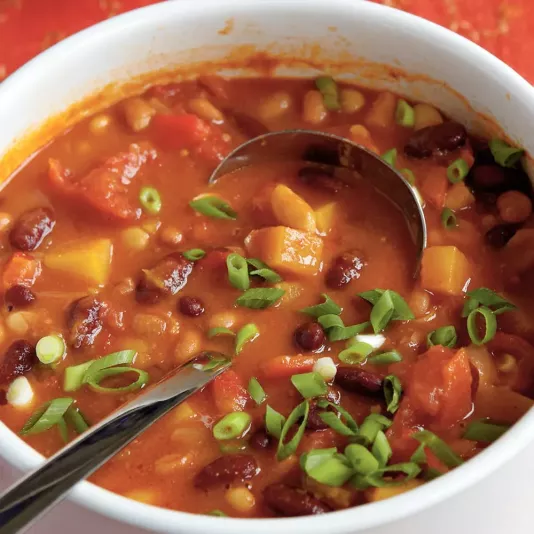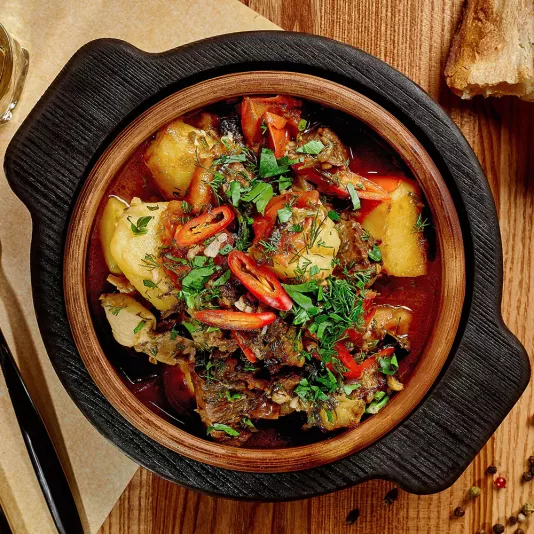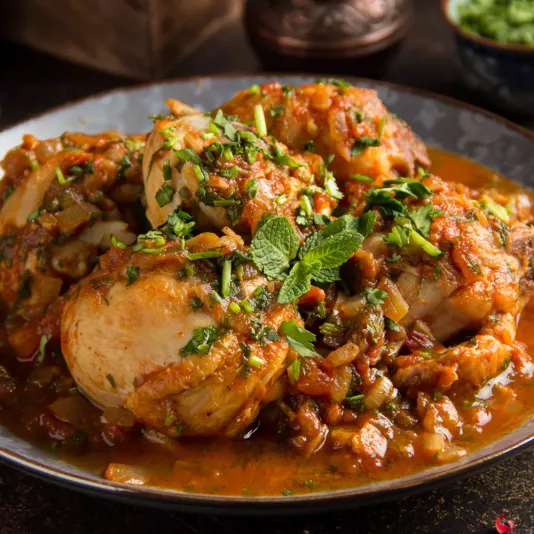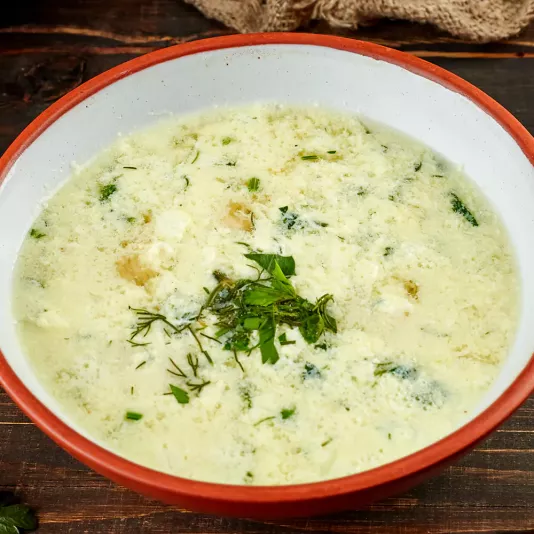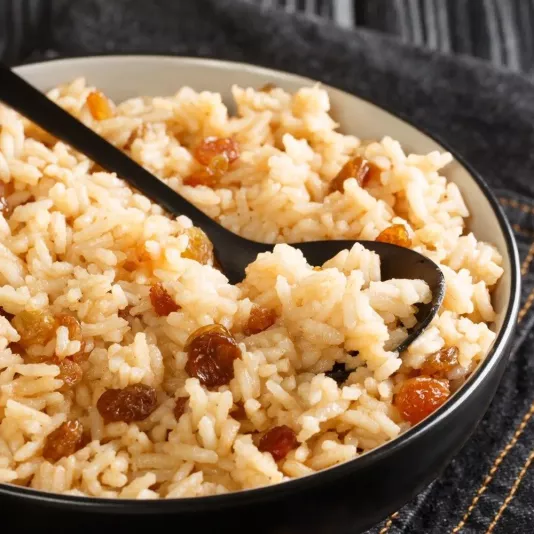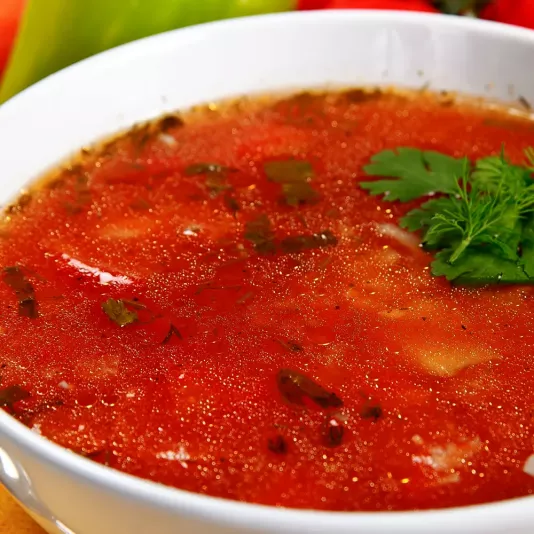Georgian Cuisine
Georgian cuisine is famous for its diversity of flavors that have evolved over centuries in the mountains and fertile valleys. Each region has its own characteristics: in the west – more herbs and walnuts, in the east – spicier seasonings and more meat. In my practice, Georgian dishes always bring people together: they are not only delicious but generous. Over the years of cooking, I’ve learned that the main thing isn’t the number of spices but harmony. It’s important to sear properly, not overdry, and allow time to rest. Even simple lobio can surprise you if you keep proportions and don’t rush. Each dish is an expression of warmth and hospitality, so Georgian cuisine for me is not just a collection of recipes but a philosophy of the shared table. I’m sure its secret lies in sincerity – in cooking not for impression but for the joy shared by everyone sitting together.
Recipes of Georgian Cuisine
For me, Georgian cuisine is always about rich aromas, a sense of home, and unhurriedness. There are no small details: even bread is baked with love, and meat is marinated to keep its juiciness. I always start with the basics – fresh ingredients and the right temperature. For example, meat for shish kebab shouldn’t be placed on overly hot coals, or it will lose its juices; and dough for khachapuri must be soft yet elastic to hold the filling. Over the years, I’ve realized that Georgian dishes love time – the process of infusion and flavor development matters. The main thing is not to fear spices but not to overuse them: khmeli-suneli or cilantro should only highlight the main ingredient. If you follow these principles, Georgian cuisine will reveal itself in full beauty: every dish will be vibrant, generous, and harmonious. And when the aroma of baked dough mingles with wine and fragrant herbs, I understand that Georgian cooking is an art of joy passed from generation to generation.
Traditional Georgian Khachapuri
Khachapuri is the heart of Georgian cuisine, and over the years I’ve learned that the key lies in the balance of dough and cheese. The dough must be elastic but not tough, with a soft crust that holds the filling. I always use fresh sulguni or Imeretian cheese, as they provide that stretchy texture and mildly salty flavor that make khachapuri unmistakable. The baking temperature should be 220°C (428°F): this way, the dough sets quickly, keeping the moisture inside. I most often make Imeretian or Adjarian variations, but the main rule for any type is not to overload the filling and not to let the cheese leak. When done right, khachapuri has the aroma of melted butter and a slightly crisp crust. I always serve them hot, cutting them right on the board so everyone can take a piece by hand – in true Georgian generosity and homeliness. And every time I see the cheese stretch behind a slice, I realize: that’s the true magic of simple yet perfect food.
Fragrant Georgian Khinkali
Khinkali are not just dumplings but a true test of mastery. In my practice, the main rule is that the dough must be thin yet strong enough to hold the meat juice. I knead it with water and a pinch of salt, letting it rest until it becomes elastic. I prepare the filling with pork and beef, adding plenty of freshly ground pepper and a bit of broth – that’s what creates the juiciness they’re loved for. Shaping khinkali requires attention: each pleat must be tight, and the top twisted firmly. I boil them in plenty of water so they don’t stick together. Ready khinkali should gently sway in the water without opening. I always emphasize: don’t cut khinkali with a knife, but hold them by the stem and bite carefully so as not to lose the juice. This small rule is a sign of respect for tradition and taste itself. Even when I serve them at home, I preserve this ritual – it adds warmth and togetherness to the meal, so typical of Georgian culture.
Georgian Sauces and Seasonings
No Georgian dish is complete without sauces, and I often say they give the cuisine its character. Satsebeli, tkemali, adjika, bazhe – each has its own aroma and purpose. In my practice, I always follow a simple principle: the sauce should enhance, not overpower, the main flavor. For tkemali, it’s crucial to balance the tartness of plums and the sharpness of garlic; if you overdo the pepper, the dish loses harmony. I make bazhe only with high-quality walnuts – they must be light-colored and not bitter. Consistency is key: too thin a sauce won’t cling to the meat. Over the years, I’ve noticed that sauces improve after a few hours of resting, as the aroma of herbs unfolds fully. That’s why when planning a Georgian meal, I always prepare sauces first, letting them mature before cooking the main dishes. And when I serve them, I see how even the simplest dish turns into a true celebration of flavor.
Meat Dishes of Georgian Cuisine
Meat in Georgian cuisine is always the foundation of a feast. Shish kebab, satsivi, chashushuli – each has its own character. I always marinate the meat for several hours so it becomes tender and infused with aromas. For shish kebab, I choose medium heat: high heat only burns the outside, while medium allows even cooking inside. In satsivi, it’s important not to overcook the walnut sauce, or it will lose color and flavor; I remove it from the heat as soon as it thickens. I cook chashushuli slowly, over low heat, letting the meat become tender and rich. I often add a bit of cilantro at the end – not earlier, so it keeps its freshness. Georgian meat dishes teach patience: haste destroys their essence. When done calmly, the meat becomes soft, and the sauce deep, with that genuine generosity for which Georgian cuisine is famous. And that’s when I see everyone at the table silent, savoring the taste – the best compliment a cook can receive.
Wine and Bread – the Soul of the Georgian Feast
No feast in Georgia is complete without wine and fresh bread. Over the years of cooking, I’ve realized that these two elements create the spirit of hospitality. Wine is not just a drink but part of the culture: it should complement the dish, not compete with it. I love serving light red with meat and dry white with vegetable dishes. I bake thin bread in a clay dish or directly on stone – the crust becomes crisp while the crumb stays soft. In my experience, bread is always the first thing guests taste – and it sets the tone for the entire meal. If it’s warm and aromatic, people immediately relax and smile. Georgian cuisine is not about complexity but about sincerity. And when there’s bread, wine, hot khinkali, and fragrant satsivi on the table, I know everything has turned out perfectly – because such food unites better than any words. And perhaps that’s the secret of its charm – the feeling of home, warmth, and respect for everyone at the table.

